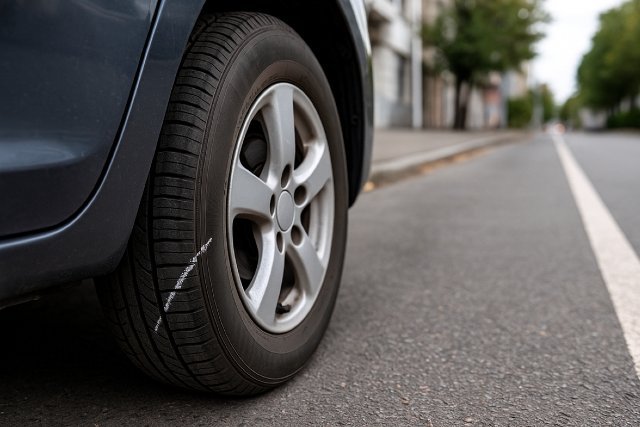
The Mystery of Chalk on Tires
Ever come back to your parked car only to notice a white chalk mark on one of your tires and wonder — what does chalk on tires do? You’re not alone. That simple mark, though seemingly harmless, plays a big role in how cities enforce parking time limits. Tire chalking is one of the oldest and simplest tools for managing limited parking spaces and monitoring how long vehicles stay in one spot.
Even in today’s digital era of license plate scanners and smart meters, tire chalking is still in use in many towns across the U.S. and beyond. But why does this old-fashioned method persist, and is it even legal anymore? Let’s dive into the fascinating history, purpose, and future of chalk marks on tires.
Understanding Tire Chalking: The Basics
What Is Tire Chalking?
Tire chalking is a traditional parking enforcement technique used to monitor how long a vehicle remains parked in a time-limited zone. Parking officers or attendants use a stick of chalk to make a small, visible mark on a tire — usually along the tread or sidewall.
When the officer returns after the parking time limit (say, two hours), they check if the car has moved. If the chalk mark is still in the same place, it’s clear that the vehicle hasn’t moved, and the driver may receive a ticket for overstaying the parking limit.
Who Uses It?
- City parking enforcement officers
- Campus security departments
- Private parking lot operators
- Residential zone monitors
How It Works Step by Step:
- A parking officer marks the tire with chalk.
- They record the location, time, and sometimes the car’s license plate.
- After the designated period, they return to inspect the tire.
- If the mark hasn’t moved, the car has overstayed — resulting in a ticket.
What Does Chalk on Tires Do?
At its core, chalk on tires serves as a time-tracking tool. The chalk helps officers determine whether a vehicle has exceeded the allowed parking time limit.
Let’s break it down further:
| Purpose | Function | Outcome |
|---|---|---|
| Time Monitoring | Tracks how long a car remains parked | Ensures parking turnover |
| Parking Regulation | Prevents vehicles from occupying spaces indefinitely | Promotes fairness in public parking |
| Law Enforcement | Supports issuing tickets legally | Generates city revenue and discipline |
This method provides a low-cost, efficient way to ensure compliance without needing expensive electronic systems.
For example, in a small city without digital parking meters, one officer with a box of chalk can effectively monitor an entire downtown area.
Why Chalking Tires Is Still Used Today
Despite being over a century old, tire chalking remains popular for several reasons:
1. It’s Simple and Cost-Effective
Unlike digital parking systems that require cameras, sensors, and software maintenance, chalk costs a few cents per stick. This makes it ideal for smaller municipalities with tight budgets.
2. It Requires No Infrastructure
Tire chalking doesn’t depend on electricity, Wi-Fi, or specialized equipment. Officers can work efficiently without worrying about technology failures.
3. It’s Effective for Small Areas
In neighborhoods or college campuses where parking zones are compact, tire chalking offers a reliable way to manage time limits without deploying complex systems.
4. It Provides Immediate Evidence
Chalk marks serve as visual proof that a car hasn’t moved, simplifying the enforcement process for officers.
Real-World Example
Cities like Ann Arbor, Michigan, and Springfield, Illinois, have used tire chalking for decades. Even after legal challenges (which we’ll discuss shortly), many have adapted the process to remain compliant while maintaining enforcement efficiency.
Is Chalking Tires Legal?
This is where things get interesting — and a bit controversial.
The Legal Debate
In 2019, a federal appeals court in Michigan ruled that chalking tires constituted a “search” under the Fourth Amendment (Sixth Circuit Court of Appeals, Taylor v. City of Saginaw). The court reasoned that marking a tire without a warrant invaded personal property, making it potentially unconstitutional.
What Does That Mean?
- In some jurisdictions, tire chalking is now considered illegal without probable cause.
- Other courts, however, have upheld it as a reasonable enforcement method.
- The result? A patchwork of laws across the U.S., with some cities banning it and others continuing to use it with legal adjustments.
Examples by Region
| State/City | Status | Notes |
|---|---|---|
| Michigan (Ann Arbor) | Illegal | Following Taylor v. Saginaw ruling |
| California (San Diego) | Still legal | Considered a civil, not criminal, matter |
| Ohio (Columbus) | Legal with consent | Applied only in municipal zones |
| Texas | Legal | No court rulings limiting use yet |
Modern Alternatives to Tire Chalking
Technology has reshaped parking enforcement in many urban areas. Today, digital systems are replacing chalk with automated precision.
1. License Plate Recognition (LPR) Systems
Mounted cameras scan license plates and record timestamps to track how long cars are parked.
Pros:
- Automated and efficient
- Reduces officer workload
- Provides digital records
Cons:
- Expensive setup
- Requires maintenance and data storage
2. Smart Parking Meters
Modern meters log exact parking durations digitally.
Pros: Accurate and integrates with mobile apps.
Cons: Requires infrastructure and power supply.
3. Digital Time-Tracking Apps
Apps like ParkMobile and PayByPhone allow users and officers to manage parking digitally.
Pros: Convenient for users
Cons: Requires smartphone access
| Method | Accuracy | Cost | Scalability |
|---|---|---|---|
| Tire Chalking | Moderate | Very Low | High |
| LPR Cameras | High | High | Medium |
| Smart Meters | High | Medium | High |
Despite these innovations, tire chalking persists because of its simplicity and reliability — especially in smaller or rural communities.
Environmental and Practical Considerations
While chalk is non-toxic and biodegradable, it still raises minor environmental concerns:
- Residue runoff during rain can leave marks on roads.
- Some newer chalks use eco-friendly, dust-free formulas that minimize pollution.
- Officers are increasingly switching to temporary paint markers made from organic materials.
On the practical side, chalking remains universally accessible — it works in any weather, requires no batteries, and is easily visible to both officers and vehicle owners.
Common Questions About Tire Chalking (FAQ Section)
1. Is chalking tires legal in my state?
Legality varies by location. Some states, such as Michigan, have court rulings against tire chalking, while others continue to use it under civil enforcement laws. Always check your city’s parking regulations.
2. Why do cops chalk tires?
Police or parking officers chalk tires to track how long a vehicle has been parked. It’s a quick and inexpensive way to enforce time-limited parking zones.
3. Does chalk damage car tires?
No. Standard parking chalk is made of non-abrasive, water-soluble materials that wash off easily without harming rubber or rims.
4. Can I remove chalk marks from my tires?
Yes. A simple wipe with a damp cloth or rain will usually remove the chalk. There’s no need for special cleaners.
5. What happens if I move my car and return to the same spot?
If you move your car even slightly — enough to rotate the tire — the chalk mark will shift. However, parking officers may note your license plate, so the tactic doesn’t always help you avoid a ticket.
The Evolution of Parking Enforcement
The first recorded use of tire chalking dates back to the 1920s, coinciding with the introduction of parking meters. Over time, it became a standard across cities worldwide, forming the backbone of parking regulation before the digital age.
In the 21st century, enforcement has evolved toward data-driven systems, but chalking continues to fill the gap where technology remains too costly or unnecessary. It represents a blend of practicality and history — a tactile reminder of how city infrastructure once operated on simple tools and trust.
Why Tire Chalking Still Matters
Even as cities modernize, tire chalking endures because it works. It’s an inexpensive, low-tech method that helps maintain parking turnover, reduces congestion, and supports small business districts reliant on accessible parking.
While court rulings have challenged its legality in some states, municipalities are adapting — some replacing chalk with digital alternatives, others reworking procedures to comply with privacy laws.
Ultimately, what chalk on tires does is more than just mark rubber — it marks the intersection of law, technology, and everyday life. Whether or not this practice fades, it has undoubtedly left its mark — literally and figuratively — on urban mobility.
Conclusion: The Enduring Simplicity of Tire Chalking
In conclusion, what chalk on tires does is simple yet effective: it helps cities keep parking fair, organized, and manageable. Though questions about legality and modernization continue, tire chalking remains a practical solution for many communities around the world.
As cities evolve toward smart parking systems, this humble piece of chalk stands as a reminder that sometimes, the simplest tools endure because they get the job done — with no batteries required.


